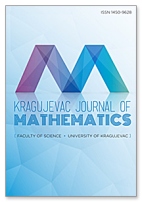Growth of Solutions of a Class of Linear Differential Equations Near a Singular Point
 Download PDF
Download PDF
Authors: S. CHERIEF AND S. HAMOUDA
DOI: 10.46793/KgJMat2302.187C
Abstract:
In this paper, we investigate the growth of solutions of the differential equation

where A , B
, B are analytic functions in the closed complex plane
except at z0 and a,b are complex constants such that ab≠0 and a = cb,
c > 1. Another case has been studied for higher order linear differential
equations with analytic coefficients having the same order near a finite
singular point.
are analytic functions in the closed complex plane
except at z0 and a,b are complex constants such that ab≠0 and a = cb,
c > 1. Another case has been studied for higher order linear differential
equations with analytic coefficients having the same order near a finite
singular point.
Keywords:
Linear differential equations, growth of solutions, finite singular point.
References:
[1] I. Amemiya and M. Ozawa, Non-existence of finite order solutions of w′′+e−zw′+Q(z)w = 0, Hokkaido Math. J. 10 (1981), 1–17.
[2] L. Bieberbach, Theorie der Gewöhnlichen Differentialgleichungen, Springer-Verlag, Berlin, Heidelberg, New York, 1965.
[3] Z. X. Chen, The growth of solutions of f′′+e−zf′+Q(z)f = 0, where the order (Q) = 1, Sci. China Math. 45 (2002), 290–300.
[4] Z. X. Chen and K. H. Shon, On the growth of solutions of a class of higher order linear differential equations, Acta Math. Sci. Ser. A 24B(1) (2004), 52–60. https://doi.org/10.1016/S0252-9602(17)30359-4
[5] Z. X. Chen and C. C. Yang, Some further results on zeros and growths of entire solutions of second order linear differential equations, Kodai Math. J. 22 (1999), 273–285. https://doi.org/10.2996/kmj/1138044047
[6] H. Fettouch and S. Hamouda, Growth of local solutions to linear differential equations around an isolated essential singularity, Electron. J. Differential Equations 2016 (2016), 10 pages.
[7] G. G. Gundersen, On the question of whether f′′ + e−zf′ + B(z)f = 0 can admit a solution f ⁄≡ 0 of finite order, Proc. Roy. Soc. Edinburgh Sect. A 102 (1986), 9–17. https://doi.org/10.1017/S0308210500014451
[8] S. Hamouda, Properties of solutions to linear differential equations with analytic coefficients in the unit disc, Electron. J. Differential Equations 2012 (2012), 9 pages.
[9] S. Hamouda, Iterated order of solutions of linear differential equations in the unit disc, Comput. Methods Funct. Theory 13(4) (2013), 545–555.https://doi.org/10.1007/s40315-013-0034-y
[10] S. Hamouda, The possible orders of growth of solutions to certain linear differential equations near a singular point, J. Math. Anal. Appl. 458 (2018), 992–1008. https://doi.org/10.1016/j.jmaa.2017.10.005
[11] W. K. Hayman, Meromorphic Functions, Clarendon Press, Oxford, 1964.
[12] A. Ya. Khrystiyanyn and A. A. Kondratyuk, On the Nevanlinna theory for meromorphic functions on annuli, Mat. Stud. 23(1) (2005), 19–30.
[13] A. A. Kondratyuk and I. Laine, Meromorphic functions in multiply connected domains, in: Fourier Series Methods in Complex Analysis, Univ. Joensuu Dept. Math. Rep. Ser. 10, Univ. Joensuu, Joensuu, 2006, 9–111.
[14] R. Korhonen, Nevanlinna theory in an annulus, in: Value Distribution Theory and Related Topics, Adv. Complex Anal. Appl. 3, Kluwer Acad. Publ., Boston, MA, 2004, 167–179. https://doi.org/10.1007/1-4020-7951-6_7
[15] I. Laine, Nevanlinna Theory and Complex Differential Equations, W. de Gruyter, Berlin, 1993. https://doi.org/10.1515/9783110863147
[16] E. L. Mark and Y. Zhuan, Logarithmic derivatives in annulus, J. Math. Anal. Appl. 356 (2009), 441–452. https://doi.org/10.1016/j.jmaa.2009.03.025
[17] M. Tsuji, Potential Theory in Modern Function Theory, Chelsea, New York, 1975 (reprint of the 1959 edition).
[18] J. Tu and C-F. Yi, On the growth of solutions of a class of higher order linear differential equations with coefficients having the same order, J. Math. Anal. Appl. 340 (2008), 487–497. https://doi.org/10.1016/j.jmaa.2007.08.041
[19] J. M. Whittaker, The order of the derivative of a meromorphic function, J. Lond. Math. Soc. s1-11 (1936), 82–87. https://doi.org/10.1112/jlms/s1-11.2.82
[20] L. Yang, Value Distribution Theory, Springer-Verlag Science Press, Berlin, Beijing, 1993. https://doi.org/10.1007/978-3-662-02915-2
